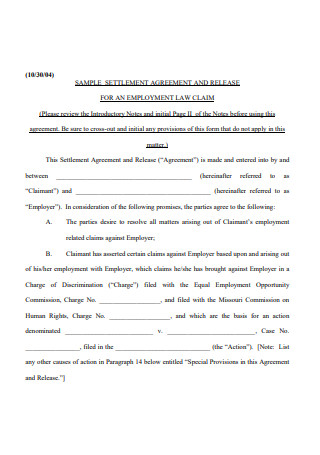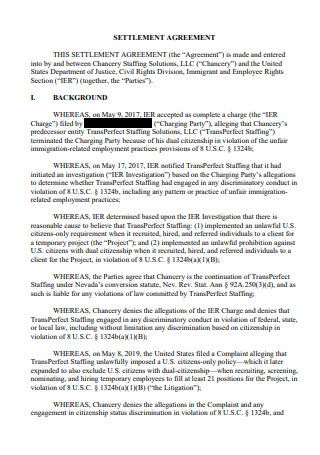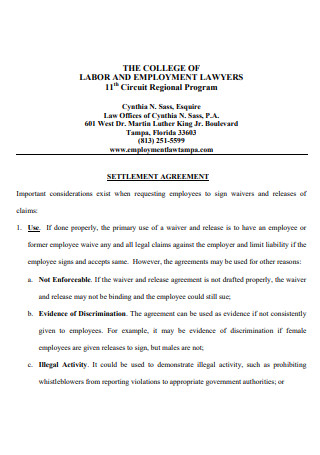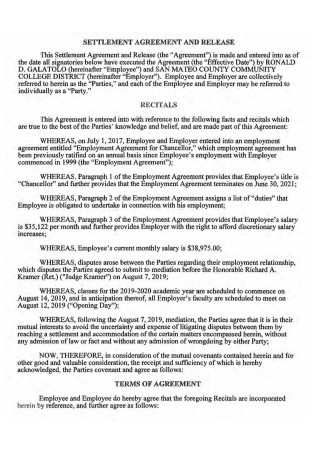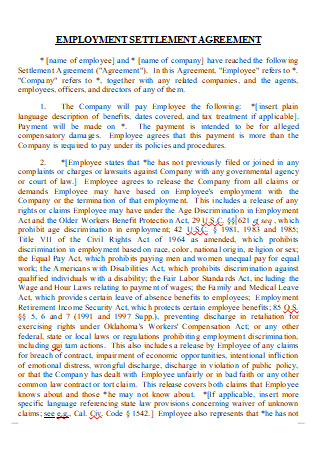4+ Sample Employment Settlement Agreement
FREE Employment Settlement Agreement s to Download
4+ Sample Employment Settlement Agreement
What Is an Employment Settlement Agreement?
Components of an Employment Settlement Agreement
How To Write an Employment Settlement Agreement
FAQs
What is the purpose of a settlement agreement?
What is an EEO settlement?
Why are employers offering settlement agreements to employees?
However, it becomes different in the professional setting, especially when misunderstandings happen between management and employees. Often, the issues stem from employee performance or grievances in the employee handbook. Since management follows company protocols, the chances of these issues repeating results in higher and graver consequences for employees if they cannot keep their attitudes or performance in check. When worse comes to worst without any resolutions, there must be an employment settlement agreement between the employer and employee. What is an employment settlement agreement, and what is its significance for employees and their employers? The article contains valuable information about the agreement, including its definition, components, and a guide to help management create one. A section also answers frequently asked questions about the document.
What Is an Employment Settlement Agreement?
Settlement agreements, or compromise agreements, are prevalent in the workplace, used by employers and the human resource departments of companies when settling work-related disputes. Employment settlement agreements serve as a negotiating tool that management uses to discuss specific terms and conditions regarding the exit of an employee in the presence of complex and sensitive issues. These issues include redundancy situations, allegations of discrimination, or unfair or wrongful termination. An employee that plans to sign the document must first consult with a labor attorney or an employment specialist. It gives the employee to determine whether the dismissal process is fair and equitable under the circumstances. For a termination settlement to be just, there must be a merit of the tribunal claim of the employee, negotiation of a higher payout, or better alternative terms after. An employee also has the right to receive legal advice on the implications of signing the settlement agreement, including future tribunals claims against the employer.
According to the United States Equal Employment Opportunity Commission, statistical information about the Enforcement and Litigation Statistics that focuses on the charges of employment discrimination and resolutions, settlement negotiations occur over 5,471 times in different statutes, equitable to 7.7 percent.
Components of an Employment Settlement Agreement
When workplace disputes happen, before employers and employees settle their differences in court, the company asks the employee to sign the settlement agreement. The document ranges from anywhere between 5 to 25 pages and can become too overwhelming to read. In most cases, employees do not have the time and opportunity to navigate the document. There are common clauses that a person can find in a settlement agreement, and the section below equips the reader with a better understanding of it. The following contains valuable information about the general components that a person can see in an employment settlement agreement.
How To Write an Employment Settlement Agreement
Settlement agreements deal with employer and employee disputes without going into trial or extending the trial if the lawsuit is already ongoing. An employment settlement agreement must undergo scrutiny in its draft and execution. When writing an employment settlement agreement, it is always critical to have a knowledgeable attorney with you or have them draft a suitable agreement for the case of an employee. The section below details helpful tips in creating an effective employment agreement.
-
1. Make the Necessary Preparations in Advance
When developing a settlement agreement or building up the case for a trial, attorneys still need to develop trial timelines, case themes, settlement, and evidentiary checklists. Attorneys are also responsible for specifying unique issues and specific takeaways to aid employees in dealing with settlement conversations. Mediation sessions require the most preparation. The goal of mediation is to bring a resolution to the claims and secure results through a signed memorandum. In mediation meetings, the attorney must have a pre-drafted settlement agreement.
-
2. Differentiate Between Settlement Negotiations and Agreements
A settlement agreement is a contract. As such, it must include necessary information, including offers, acceptances, mutual agreements on terms, and considerations. Exploring various settlement options allows the parties to distinguish between essential terms that require identification and communication before a binding offer.
-
3. Be Cautious of Boilerplate Clauses
Most attorneys have a template or pre-draft of an agreement to help them communicate the most necessary information to their clients. Attorneys find the danger in drafting the agreement in assuming the usual provisions without analyzing, modifying, and appropriating sections under certain circumstances. Integration clauses are present in employment settlement agreements to avoid future misunderstandings and arguments when one party retains claims against the other. Some clients will not want this in their agreements. Writing the confidentiality or non-disparagement clauses is necessary from a defensive stance. There are instances that an organization distrusts their employees to keep things confidential, and writing the non-disparagement clause will bring more harm than good. Release clauses are also essential in any settlement agreement. It is necessary to identify all the claims that the client needs to release. Also, make sure that the client has the legal capacity to release claims about the issue.
-
4. Speak with Tax Counsels
Settlement agreements deal with settlement payments that carry over tax consequences on both parties. Understand the consequences in advance to not make unnecessary commitments for the client. There are instances that a client cannot lawfully keep or regret in the long run.
-
5. Indicate Some Enforcement Provisions
Despite having a settlement agreement, disputes can arise if there is poor drafting, bad faith, or buyer remorse. It is best to anticipate the possibility of these happening and the possible steps of resolving them. Guarantee there is an enforceable agreement to arbitrate these scenarios according to law. The agreement must come from the specific jurisdiction or venue of the document and specify whether the losing party shoulders the expenses and fees of its enforcement.
-
6. Schedule Essential Reviews with the Client
An attorney must be responsible for sending the necessary documents to their clients. When sending the draft of the settlement agreement, make sure it is consistent with the attorney’s and client’s expectations and understanding. To make sure that a client understands the content of the settlement agreement, the best thing to do is to review its entirety in their presence, explaining each section. A client has already put in emotional and financial investments to the case, and as such, the attorney must put the best interest of the client first and ensure their effort is consistent with the client’s expectations.
FAQs
What is the purpose of a settlement agreement?
The principal purpose of a settlement agreement is to resolve disputes between employers and employees by coming into a mutual agreement. A settlement agreement is usually in the civil law setting, where the parties agree to an outcome in advance.
What is an EEO settlement?
An EEO (equal employment opportunity) settlement focuses on addressing discrimination claims between an employer and an employee.
Why are employers offering settlement agreements to employees?
Employers offer settlement agreements to employees to negotiate and mutually agree on terms regarding the termination of the contract. It also establishes a clean break of employees from the organization without bringing claims to a higher court or tribunal for more money.
Employment settlement agreements are vital documents in the business sector, especially for employers. Each document is unique, depending on the situation or scenario of the employer and employee. The employment settlement agreement is beneficial for terminating employee contracts, employee redundancy, settling employment disputes, and protecting the employer’s interest. Writing an employment settlement agreement requires the aid of an attorney at all times. Draft the document with an attorney and familiarize yourself with its contents by downloading from the 4+ SAMPLE Employment Settlement Agreement in PDF | MS Word above. Get yours today, only at Sample.net.

